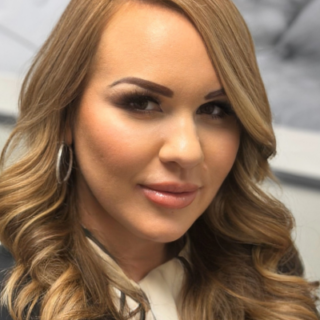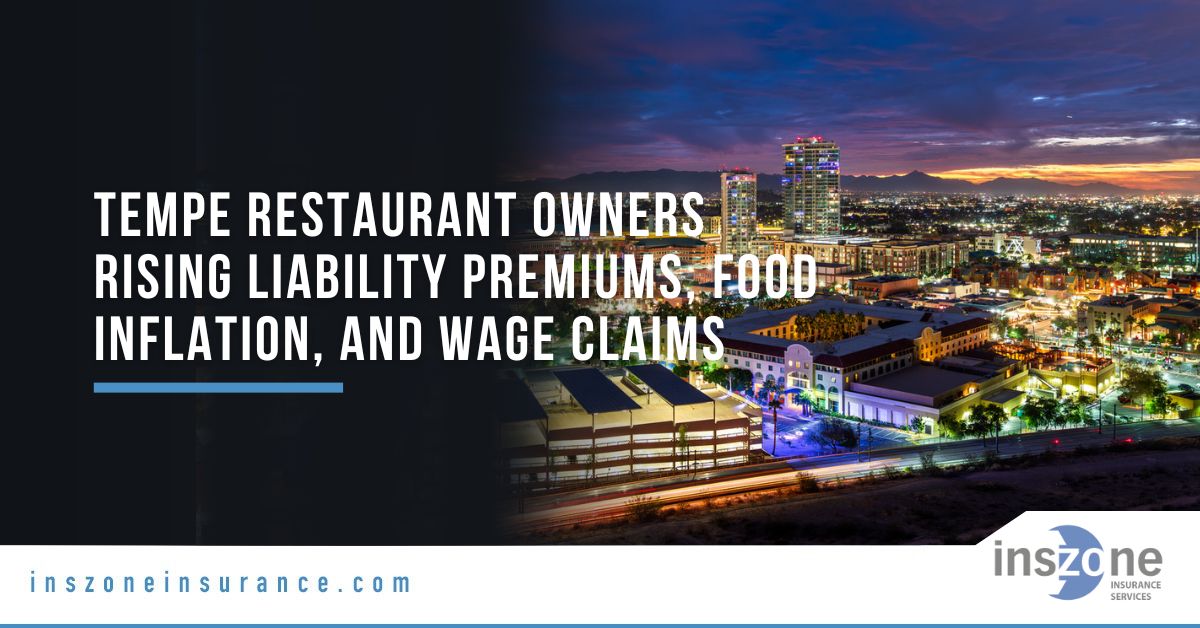Tempe’s restaurant scene is still vibrant, but 2025 is testing margins. Insurance markets are tighter for hospitality, food costs aren’t easing much, and labor rules keep shifting. Below is a simple, fact-checked playbook—what’s changed, who’s feeling it most, and how to protect your bottom line without stripping out coverage.
What changed in 2025—at a glance
| Factor | 2025 Update | Why It Matters to You |
|---|---|---|
| General & Liquor Liability | Commercial P&C pricing is still up overall (~3–5% on average across lines in Q2 2025), but hospitality/liquor can run higher depending on losses and controls. | Expect single-digit increases if your loss runs and training are clean; higher if you’ve had alcohol-related or premises claims. |
| Food Inflation (Restaurants) | “Food away from home” prices were up about 3.9% year-over-year (Aug. 2025). | Menu costs keep creeping; build small, periodic price moves and portion control into your plan. |
| Arizona Minimum Wage | State minimum wage increased to $14.70 on Jan 1, 2025 (tipped credit max $3.00). | Payroll costs and wage-and-hour compliance exposure rise; EPLI and clear timekeeping become more important. |
| Workers’ Compensation (AZ) | NCCI indicates continued improvement; proposed further average rate decreases for 2026 after 2025 reductions. | Savings are available, but claims frequency and payroll audits still drive what you actually pay. |
| Kitchen Fire Controls | NFPA 96 inspections/cleanings and documentation remain key; some 2025 updates emphasize frequency for high-volume operations. | Clean hood logs and compliance evidence can unlock property/loss-control credits and prevent nonrenewals. |
Why insurance costs are climbing faster than menu prices
Litigation severity remains elevated. National data show continued “nuclear” verdict pressure in liability lines, and hospitality is a frequent target. Even with some market softening, carriers price for higher injury awards and defense costs—especially where alcohol is served.
Liquor liability scrutiny is intense in AZ. Arizona’s dram-shop framework (Title 4) narrows liability to “obviously intoxicated” service under statute, but that hasn’t eliminated large verdict risk from alcohol-involved incidents. Underwriters look closely at server training, incident logging, cut-off policies, and closing procedures.
Premises claims haven’t gone away. Slip-and-fall frequency in food service remains a driver. Carriers weigh flooring, footwear policies, spill response logs, and video retention when pricing GL.
Labor risk is up. With a higher state minimum wage in 2025, restaurants are updating tip credits, timekeeping, and break policies. EPLI underwriters want to see compliant handbooks and signed acknowledgments to control pricing.
Who in Tempe is feeling the pinch
- Late-night bars, taprooms, and music venues with extended alcohol service hours and live events—higher liquor-liability surcharges if controls are thin.
- Mom-and-pop diners in older buildings—outdated hood/ANSUL systems and wiring can push property rates and trigger underwriting questions.
- Food trucks and ghost kitchens—missed coverages (auto for owned units, hired/non-owned auto for deliveries, inland marine for equipment) often surface at claim time.
- Concepts with delivery—commercial auto rates remain elevated; driver screening and telematics can be the difference between a modest and steep renewal.
Where you can still find savings (without losing protection)
- Documented hood/duct maintenance: Keep NFPA 96 inspection/cleaning certificates quarterly (or more frequently if high volume). Submit them at marketing—some carriers apply property or GL credits when proof is consistent.
- Alcohol-server training: Use Arizona Title 4–approved providers and keep completion logs. Verified training often earns preferred liquor tiers.
- Bundle smart: EPLI attached to a package or management-liability program can be cheaper than buying stand-alone—especially for small staff counts with good HR hygiene.
- Workers’ comp “pay-as-you-go”: Match premium to real payroll and reduce audit surprises; combine with a return-to-work plan to keep the experience mod healthy.
When to review, re-shop, or adjust coverage
- 90–120 days pre-renewal: Give underwriters time to price your story—clean hood logs, Title 4 training rosters, incident logs, and updated driver lists.
- After menu or alcohol changes: New cocktail programs, happy-hour extensions, or third-party delivery can change rating and need endorsements.
- Post-renovation or equipment upgrades: Re-set building limits, business income values, and equipment schedules to avoid underinsurance at claim time.
How to lower premiums while staying protected
- Right-size deductibles: Moving a property deductible (e.g., $1,000 → $2,500) often trims premium meaningfully while keeping catastrophes insurable. Test different options in quotes.
- Add an entry-level umbrella: $1–2M umbrellas are often affordable and can let you balance primary GL/liquor limits without reducing total protection.
- Prove a safety culture: Daily floor checks, non-slip footwear policy, CCTV retention, and incident-report templates can unlock GL credits.
- Deploy telematics for delivery: App-based monitoring with scorecards plus MVR/driver-agreement files can reduce commercial auto pricing and keep you marketable.
- EPLI basics: Signed handbooks, time-clock attestations, and manager training reduce wage-and-hour claim risk and keep EPLI pricing in check.
Quick answers to common owner questions
“Are liability premiums really up 9–14%?” It depends on losses and controls. Broad market data show average commercial P&C increases around the low-single-digits in 2025, but hospitality/liquor can be higher—especially with prior claims or weak controls. Ask brokers to market your risk with your proof (training, maintenance, incident logs) to target preferred tiers.
“Does AZ’s dram-shop law shield me if a patron causes harm off-premises?” No. Arizona limits claims to “obviously intoxicated” service under statute, but large verdicts still occur in serious cases nationally. Carriers price to that severity risk. Title 4 training, cut-off rules, and documentation are key defenses.
“Food inflation says 7%—is that current?” Recent BLS data put restaurant (“food away from home”) inflation closer to ~4% year-over-year in August 2025. Build smaller, more frequent menu adjustments and cost controls rather than big, rare hikes that hit demand.
“Is workers’ comp the one bright spot?” For many Arizona restaurants, yes. Statewide filings show ongoing rate decreases, with more proposed for 2026. Keep claims management tight and consider pay-as-you-go to capture savings and avoid audit pain.
Action checklist for Tempe operators
- Pull loss runs and collect artifacts: Title 4 training certificates, hood/duct cleaning logs, incident reports, driver roster/MVRs.
- Ask for quotes that isolate credits tied to your documentation (kitchen maintenance, alcohol training, telematics).
- Price deductible options and a $1–$2M umbrella—often the best dollar-for-dollar protection.
- Refresh HR docs (handbook, wage/tip policies, timekeeping) and confirm EPLI terms match your exposure.
Sources and Further Reading
- U.S. Bureau of Labor Statistics, Consumer Price Index – August 2025 (Food away from home +3.9% y/y). Live PDF and release: bls.gov/news.release/pdf/cpi.pdf, bls.gov/news.release/cpi.nr0.htm.
- Industrial Commission of Arizona, 2025 Minimum Wage Poster (State minimum wage $14.70; tipped credit $3.00). azica.gov/resources/minimum-wage-poster-2025-english.
- U.S. DOL, Minimum Wages for Tipped Employees (Arizona details). dol.gov/agencies/whd/state/minimum-wage/tipped.
- The Council of Insurance Agents & Brokers (CIAB), Q2 2025 P/C Market Survey (average increases ~3.7%). ciab.com/resources/q2-2025-p-c-market-survey and survey PDF: Q2-2025-survey_FINAL.pdf.
- Insurance Journal summary of CIAB Q2 2025 (line-by-line trends). insurancejournal.com/news/national/2025/08/15/835835.htm.
- NCCI Arizona, State Advisory Forum 2025 (continued improvement; proposed 2026 decreases). ncci.com/Articles/Documents/II_StateAdvisoryForumState_AZ_2025.pdf.
- Arizona DIFI, Workers’ Compensation Rates Decrease (2025). difi.az.gov/announcementnews/workers-compensation-rates-decrease-10th-consecutive-year-0.
- Arizona Department of Liquor Licenses & Control, Approved Title 4 Training Providers. azliquor.gov/communications/trainers/PrintTrainerList.cfm.
- NFPA 96 context and 2025 updates for high-volume operations (industry summaries). donerighthfs.com/nfpa-96-2025-updates, general overview: exhaustclean.com/blog/fire-safety-regulations-in-commercial-kitchen-hood-cleaning/.
- Arizona dram-shop legal framework update (Torres v. JAI Dining Services, 2023). mwl-law.com/arizona-supreme-court-eliminates-common-law-dram-shop-actions-torres-v-jai-dining-services-phoenix-inc-2023-wl-6801025-ariz-2023/ and analysis: arizonastatelawjournal.org/2023/11/14/torres-v-jai-dining-services-a-major-loss-for-victims-of-drunk-driving-in-arizona/.
- Hospitality insurance conditions in 2025 (industry reports). imacorp.com/insights/hospitality-risk-in-focus-q3-2025, risk-strategies.com/hubfs/25%20State%20of%20the%20Hospitality%20Insurance%20Market.pdf.





